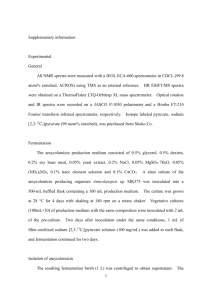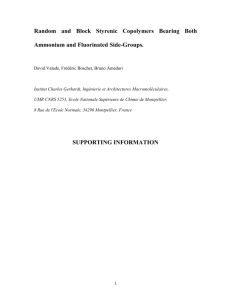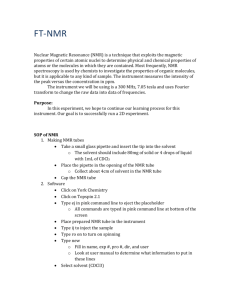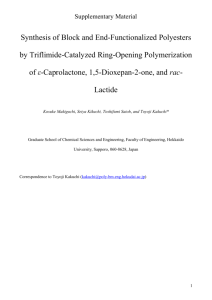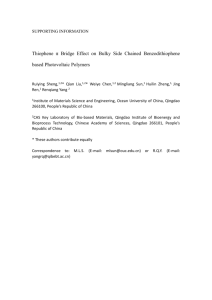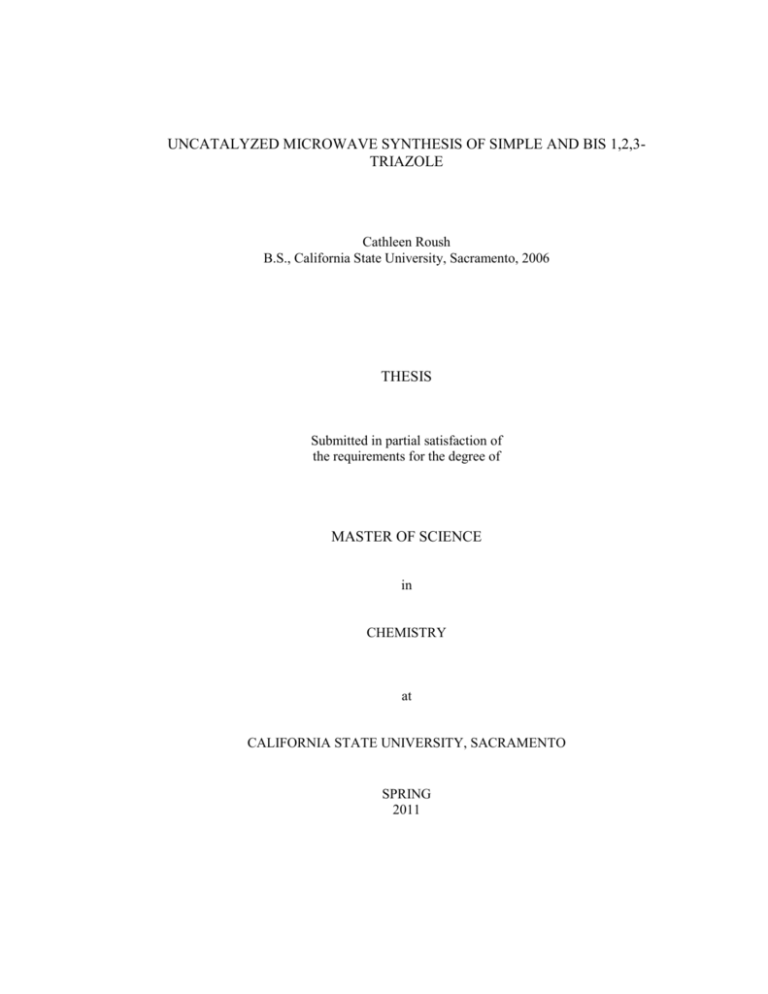
UNCATALYZED MICROWAVE SYNTHESIS OF SIMPLE AND BIS 1,2,3TRIAZOLE
Cathleen Roush
B.S., California State University, Sacramento, 2006
THESIS
Submitted in partial satisfaction of
the requirements for the degree of
MASTER OF SCIENCE
in
CHEMISTRY
at
CALIFORNIA STATE UNIVERSITY, SACRAMENTO
SPRING
2011
© 2011
Cathleen Roush
ALL RIGHTS RESERVED
ii
UNCATALYZED MICROWAVE SYNTHESIS OF SIMPLE AND BIS 1,2,3TRIAZOLE
A Thesis
by
Cathleen Roush
Approved by:
__________________________________, Committee Chair
Dr. Cynthia Kellen-Yuen
__________________________________, Second Reader
Dr. Katherine McReynolds
__________________________________, Third Reader
Dr. James Miranda
____________________________
Date
iii
Student: Cathleen Roush
I certify that this student has met the requirements for format contained in the University format
manual, and that this thesis is suitable for shelving in the Library and credit is to be awarded for
the thesis.
__________________________, Department Chair
Dr. Linda Roberts
Department of Chemistry
iv
___________________
Date
Abstract
of
UNCATALYZED MICROWAVE SYNTHESIS OF SIMPLE AND BIS 1,2,3TRIAZOLE
by
Cathleen Roush
Triazoles are a type of hertocyclic amine which can be found in a variety of useful
and bioactive compounds, ranging from agrochemicals and photochemical products to
antifungal drugs and pharmaceutical substances. The classic synthesis for the 5membered triazole ring is accomplished through a synthetic approach known as “Click
Chemistry”. The syntheses of a variety of 4,5-disubstituted-1,2,3-triazoles and bis-1,2,3triazoles (Figure 1) have been carried out via a new, “Green” synthetic method which
involves the absence of solvent and catalyst, and is carried out using a domestic
microwave oven. This new synthetic method provides a fast and efficient technique to
obtain various types of triazoles in good to excellent yields. It has also been shown to be
an effective alternative to the classical synthesis, without the use of toxic and
environmentally unsafe solvents or catalysts.
v
O
H2C
H3CO2C
Ph
O
O
N
N
N
N
N
H3CO2C
O
N
O
O
O
H2
C
H3C
O
H
C
N
N
N
N
N
C
N
H
O
O
C
H2
CH3
Figure 1. Examples of 4,5-disubstituted-1,2,3-triazoles and bis-1,2,3-triazoles.
_________________________________, Committee Chair
Dr. Cynthia Kellen-Yuen
_______________________
Date
vi
ACKNOWLEDGMENTS
To Dr. Kellen-Yuen: Thank you so much for sharing your time, your lab, and
your knowledge with me over the last six years. I hope that I will be able to live up to
your example as a chemist.
To my mother and father: Thank you so much for always believing in me,
encouraging me to do my best and being there for me when I needed you most. To my
father, who taught me that the best kind of knowledge to have is that which is learned for
its own sake. To my mother, who taught me that even the largest task can be
accomplished if it is done one step at a time. I love you both very much!
To my husband, Thomas Roush: Thanks for putting up with the crazy long study
nights. You have always believed in me and were there for me when I needed you most. I
appreciate it more that you will ever know.
Additional thanks goes to Dr. McReynolds and Dr. Miranda for graciously
agreeing to be on my graduate committee, as well as to my fellow graduate students,
including Karen Goodwin, Eric Martin, Mike Payne and Will Kerlin. Thanks for being
my study buddies and my friends!
vii
TABLE OF CONTENTS
Page
Acknowledgments.................................................................................................................. vii
List of Tables ........................................................................................................................... ix
List of Figures ........................................................................................................................... x
List of Schemes ...................................................................................................................... xii
Chapter
1. INTRODUCTION………………………………………………………………………. 1
Background………………..……………………………………………………….. 1
1,3-Dipolar Cycloaddition ....................................................................................... 4
Brief History for the Discovery and Optimization of the 1,2,3Triazole ..................................................................................................................... 10
Brief History for the Discovery and Optimization of Microwave
Chemistry .................................................................................................................. 20
Statement of Problem................................................................................................. 25
2. RESULTS AND DISCUSSION – BACKGROUND ANALYSIS ................................... 26
Single 1,2,3-Triazoles ................................................................................................ 31
3. RESULTS AND DISCUSSION – CURRENT WORK ................................................... 43
Isomers of Simple 1,2,3-Triazoles ............................................................................. 43
Synthesis of Bis-1,2,3-Triazoles ................................................................................ 61
Other Attempted Reactions ........................................................................................ 70
4. CONCLUSIONS............................................................................................................... 72
5. EXPERIMENTAL……………………………………………………………………… 74
General Information………...……………………………………………………….74
Synthesis of Azide Starting Materials........................................................................ 75
Mono-1,2,3-Triazoles ................................................................................................ 77
Bis-1,2,3-Triazoles..................................................................................................... 84
REFERENCES ....................................................................................................................... 86
viii
LIST OF TABLES
Page
1.
Table 1 1,3-Dipoles useful in cycloaddition reactions…………………………....7
2.
Table 2 1,3-Dipolar cycloaddition reactions between an alkyne and azide to
produce simple 1,2,3-triazoles .…………....……….………………………....... 32
3.
Table 3 1,3-Dipolar cycloaddition reactions between an alkyne and azide to
produce non-regiospecific 1,2,3-triazoles ….…..….…………………………… 45
4.
Table 4 Reactions between an alkyne and 1,4-bis(azidomethyl)benzene………..63
ix
LIST OF FIGURES
Page
1.
Figure 1 Examples of 4,5-disubstituted-1,2,3-triazoles and bis-1,2,3-triazoles......vi
2.
Figure 2 Structure of an unsubstituted 1H-1,2,3-triazole……………………………1
3.
Figure 3 1H NMR Spectrum of dimethyl 1H-1,2,3-triazole-4,5-dicarboxylate in
d6-DMSO ……………………………….…………………………………………..........2
4.
Figure 4 Pechmann's proposed unsaturated triazole ring………………...………...11
5.
Figure 5 Various azides used in this study ….…………………………………........28
6.
Figure 6 Glassware used for the optimized reactions ……………………………...29
7.
Figure 7 The 1H NMR of 1-benzyl-1,2,3-triazole…………………………………..34
8.
Figure 8 The 1H NMR of 1-benzyl-4,5-diphenyl-1,2,3-triazole in CDCl3….…....35
9.
Figure 9 The 13C NMR of 1-benzyl-4,5-diphenyl-1,2,3-triazole in CDCl3……...36
10.
Figure 10 The 1H NMR of dimethyl-1-benzyl-1,2,3-triazole-4,5-carboxylate in
CDCl3……………………………..………….………………………………….….…..38
11.
Figure 11 The 1H NMR of dimethyl-1-benzyl-1,2,3-triazole-4,5-carboxylate
in d6-DMSO………………….………………………………...……………..………..38
12.
Figure 12 The 1H NMR of dimethyl-1-(2-ethoxy-2-oxoethyl)-1,2,3-triazole4,5-carboxylate in CDCl3.………….…………….……….…………………………..39
13.
Figure 13 The 1H NMR of dimethyl-1H-1,2,3-triazole-4,5-carboxylate ….……..41
14.
Figure 14 Dimethyl-1H-1,2,3-triazole-4,5-carboxylate …………..…………...…..41
15.
Figure 15 The 1H NMR of 1-benzyl-4-phenyl-1,2,3-triazole in CDCl3…….……46
16.
Figure 16 The 1H NMR of 1-benzyl-5-phenyl-1,2,3-triazole in CDCl3….………47
17.
Figure 17 The 1H NMR of ethyl 1-benzyl-4-phenyl-1,2,3-triazole-5-carboxylate
CDCl3……………………………………………………………………………..…….49
x
18.
Figure 18 The 1H NMR of ethyl 1-benzyl-5-phenyl-1,2,3-triazole-4-carboxylate
CDCl3………………………………………………………………….…………..……49
19.
Figure 19 The 1H NMR of 1-benzyl-4-pyridyl-1,2,3-triazole in CDCl3….………52
20.
Figure 20 The 1H NMR of 1-benzyl-5-pyridyl-1,2,3-triazole in CDCl3……….…52
21.
Figure 21 nOe spectrum for 1-benzyl-4-pyridinyl-1,2,3-triazole in CDCl3……... 54
22.
Figure 22 nOe spectrum for 1-benzyl-5-pyridinyl-1,2,3-triazole in CDCl3….…. 54
23.
Figure 23 The 1H NMR of 1-(2-(2-azidoethoxy)ethanol)-4-hydroxymethyl1,2,3-triazole in CDCl3…………………………….……………………..………….. 57
24.
Figure 24 The 1H NMR of 1-(2-(2-azidoethoxy)ethanol)-5-hydroxymethyl1,2,3-triazole in CDCl3……………..……….……………………………………….. 57
25.
Figure 25 1H NMR of 1-(2-(2-azidoethoxy)ethanol)-4-hydroxymethyl-1,2,3triazole in CDCl3 showing the D2O exchange from alcohol to a deuterated
alcohol ……………………………….……………………………..……………..…... 59
26.
Figure 26 1H NMR of 1-(2-(2-azidoethoxy)ethanol)-5-hydroxymethyl-1,2,3triazole in CDCl3 showing the D2O exchange from alcohol to a deuterated
alcohol ……………………………….……………...…………………………….…... 59
27.
Figure 27 The 1H NMR of tetramethyl 1,1’-(p-phenylenedimethylene)bis [1H1,2,3-triazole-4,5-dicarboxlate] in CDCl3……………………………………...…… 65
28.
Figure 28 The 1H NMR of tetraphenyl 1,1’-(p-phenylenedimethylene)bis [4,5diphenyl-1H-1,2,3-triazole] in CDCl3……………………………….……......……. 67
29.
Figure 29 The 1H NMR of diethyl 1,1’-(p-phenylenedimethylene)bis[1H-1,2,3triazole-4-carboxylate] in CDCl3…………………………………………………..... 68
30.
Figure 30 Alkynes used for attempted reactions ………………………….……...... 70
xi
LIST OF SCHEMES
Page
1.
Scheme 1 Alkyne and an azide producing a 1,2,3-traizole ……………………...….4
2.
Scheme 2 Resonance structures of CH2N2………………………………………........5
3.
Scheme 3 Example of a 1,3-dipolar cycloaddition reaction ………………………..8
4.
Scheme 4 The nitration of diphenyldiazene-1-oxide ………………………………10
5.
Scheme 5 Example reactions by which Pechamnn made 1,2,3-triazoles ………...12
6.
Scheme 6 von Pechmann synthesis of 1H-1,2,3-triazole ………………………….13
7.
Scheme 7 Bladin synthesis of 1H-1,2,3-triazole ……………………………….......13
8.
Scheme 8 Acetylene and hydrogen azide producing 1H-1.2.3-traizole ………….14
9.
Scheme 9 Example of regioisomeric products when using unsymmetric alkyne..16
10.
Scheme 10 Copper-(I) catalyzed Azide-Alkyne Cycloaddition (CuAAC) mechanism.
The blue in denoted for the alkyl azide and the red is denoted for the alkyne…...17
11.
Scheme 11 Ruthenium-Catalyzed Cycloaddition of Benzyl Azide to
Phenylacetylene………………………………………………………………….……..18
12.
Scheme 12 Formation of a derivative of 1,2,3-triazole using an azide and an
Ylide……………………………….………………………..………………………..….23
13.
Scheme 13 1,3-Dipolar Cyclization forming a 1,2,3-Triazole, where R, R2 and R3
are carbon based substitutents ……………………………….…………………...…..26
14.
Scheme 14 Decarboxylation of a carboxylic acid ………………………………….33
15.
Scheme 15 Purposed mechanistic pathway affording dimethyl-1H-1,2,3-triazole4,5-carboxylate……………………………………………………………..……….….42
16.
Scheme 16 Example of regioisomeric products when using unsymmetric
alkyne ……………………………….………………………………………...………...44
xii
17.
Scheme 17 Symmetrically substituted bis(1,2,3-triazoles) ………...…….......……61
xiii

